Impact of Culture, Power, and Politics on Individuals and Organizations
VerifiedAdded on 2022/12/27
|16
|4744
|30
AI Summary
This report examines the impact of culture, power, and politics on individuals and organizations, using Marks & Spencer as a case study. It assesses the role of organizational culture, the influence of politics, and the use of power within the company. The report also evaluates motivational theories and explores ways to create effective teams. The findings highlight the importance of understanding these factors in achieving organizational goals.
Contribute Materials
Your contribution can guide someone’s learning journey. Share your
documents today.
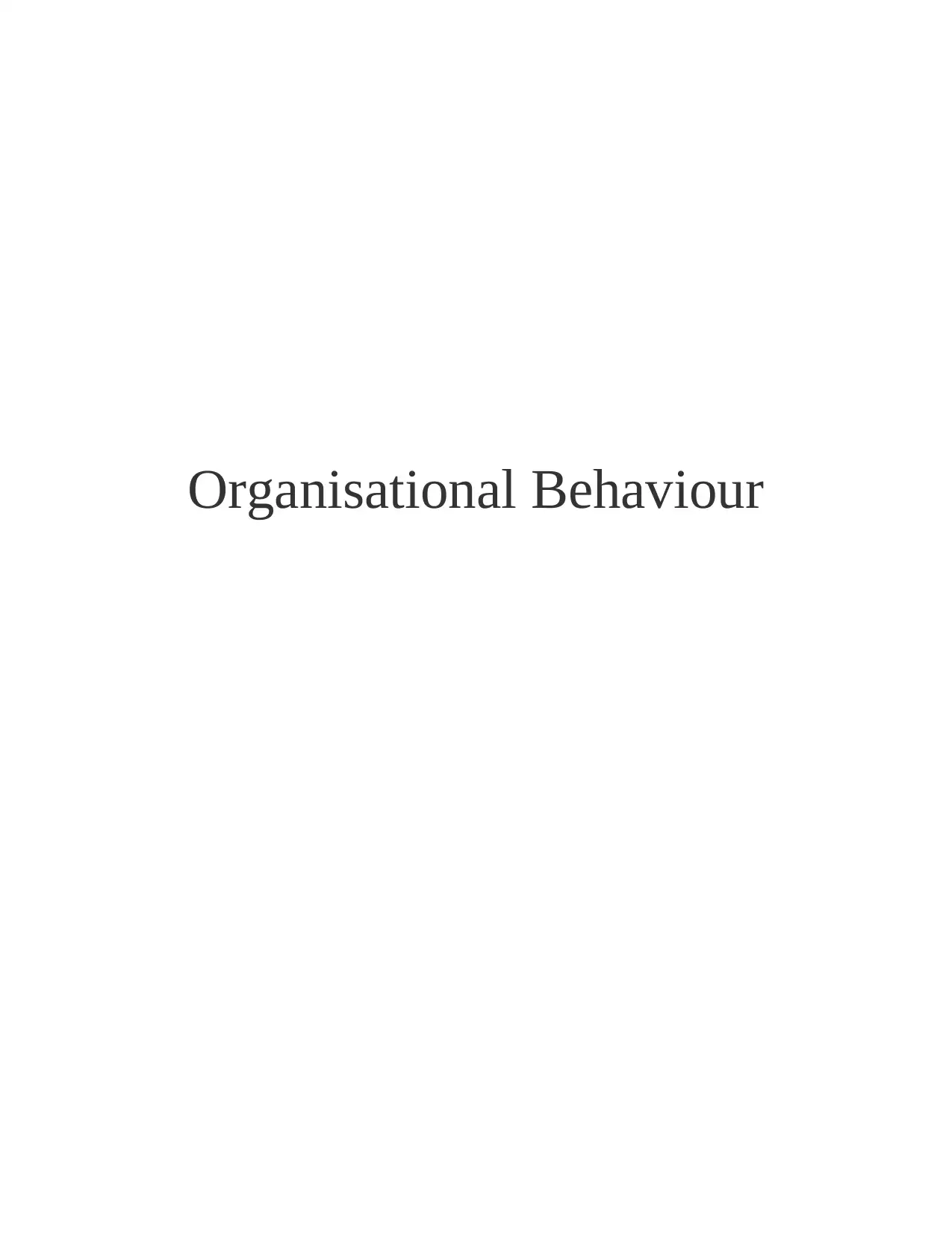
Organisational Behaviour
Secure Best Marks with AI Grader
Need help grading? Try our AI Grader for instant feedback on your assignments.
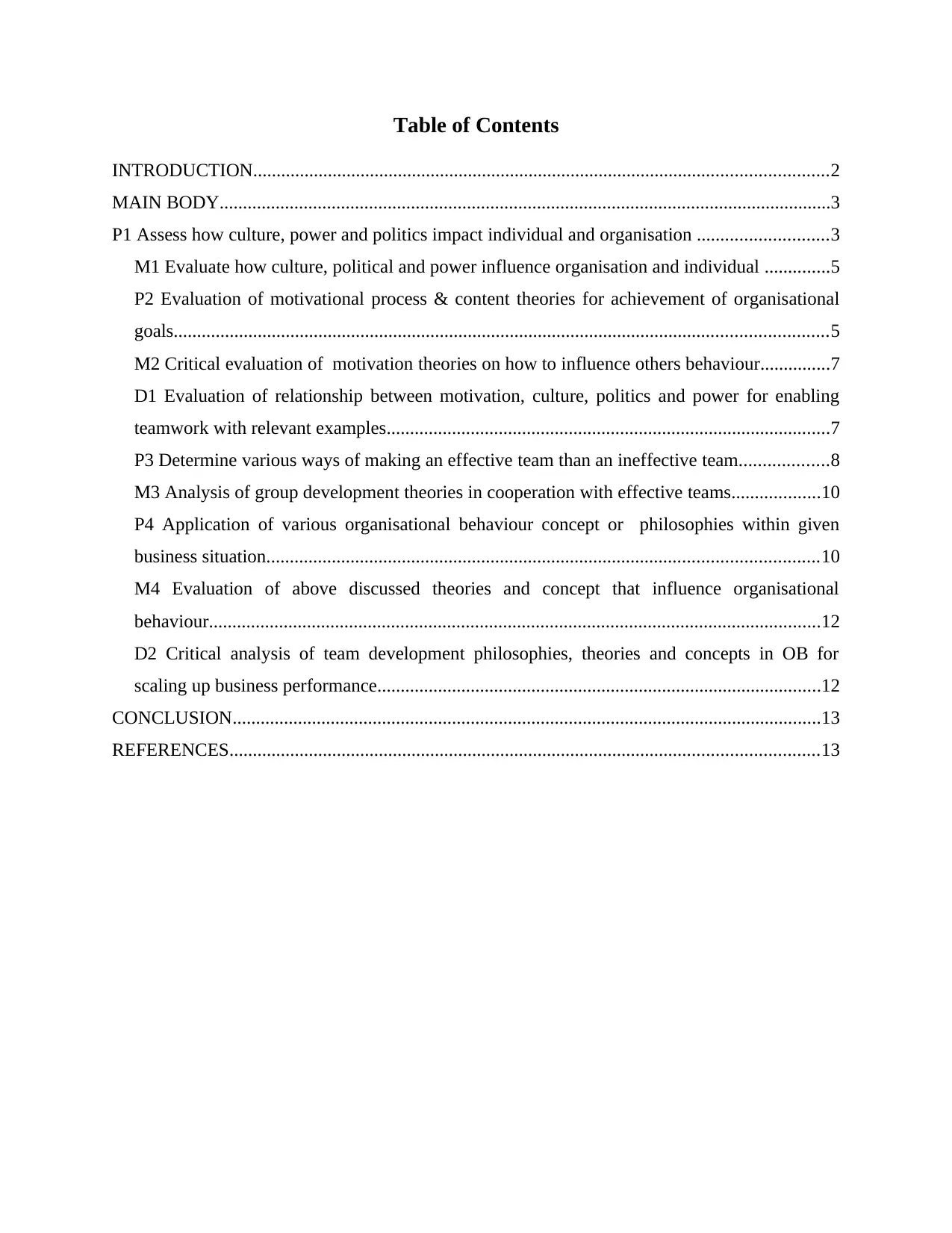
Table of Contents
INTRODUCTION...........................................................................................................................2
MAIN BODY...................................................................................................................................3
P1 Assess how culture, power and politics impact individual and organisation ............................3
M1 Evaluate how culture, political and power influence organisation and individual ..............5
P2 Evaluation of motivational process & content theories for achievement of organisational
goals............................................................................................................................................5
M2 Critical evaluation of motivation theories on how to influence others behaviour...............7
D1 Evaluation of relationship between motivation, culture, politics and power for enabling
teamwork with relevant examples...............................................................................................7
P3 Determine various ways of making an effective team than an ineffective team...................8
M3 Analysis of group development theories in cooperation with effective teams...................10
P4 Application of various organisational behaviour concept or philosophies within given
business situation......................................................................................................................10
M4 Evaluation of above discussed theories and concept that influence organisational
behaviour...................................................................................................................................12
D2 Critical analysis of team development philosophies, theories and concepts in OB for
scaling up business performance...............................................................................................12
CONCLUSION..............................................................................................................................13
REFERENCES..............................................................................................................................13
INTRODUCTION...........................................................................................................................2
MAIN BODY...................................................................................................................................3
P1 Assess how culture, power and politics impact individual and organisation ............................3
M1 Evaluate how culture, political and power influence organisation and individual ..............5
P2 Evaluation of motivational process & content theories for achievement of organisational
goals............................................................................................................................................5
M2 Critical evaluation of motivation theories on how to influence others behaviour...............7
D1 Evaluation of relationship between motivation, culture, politics and power for enabling
teamwork with relevant examples...............................................................................................7
P3 Determine various ways of making an effective team than an ineffective team...................8
M3 Analysis of group development theories in cooperation with effective teams...................10
P4 Application of various organisational behaviour concept or philosophies within given
business situation......................................................................................................................10
M4 Evaluation of above discussed theories and concept that influence organisational
behaviour...................................................................................................................................12
D2 Critical analysis of team development philosophies, theories and concepts in OB for
scaling up business performance...............................................................................................12
CONCLUSION..............................................................................................................................13
REFERENCES..............................................................................................................................13
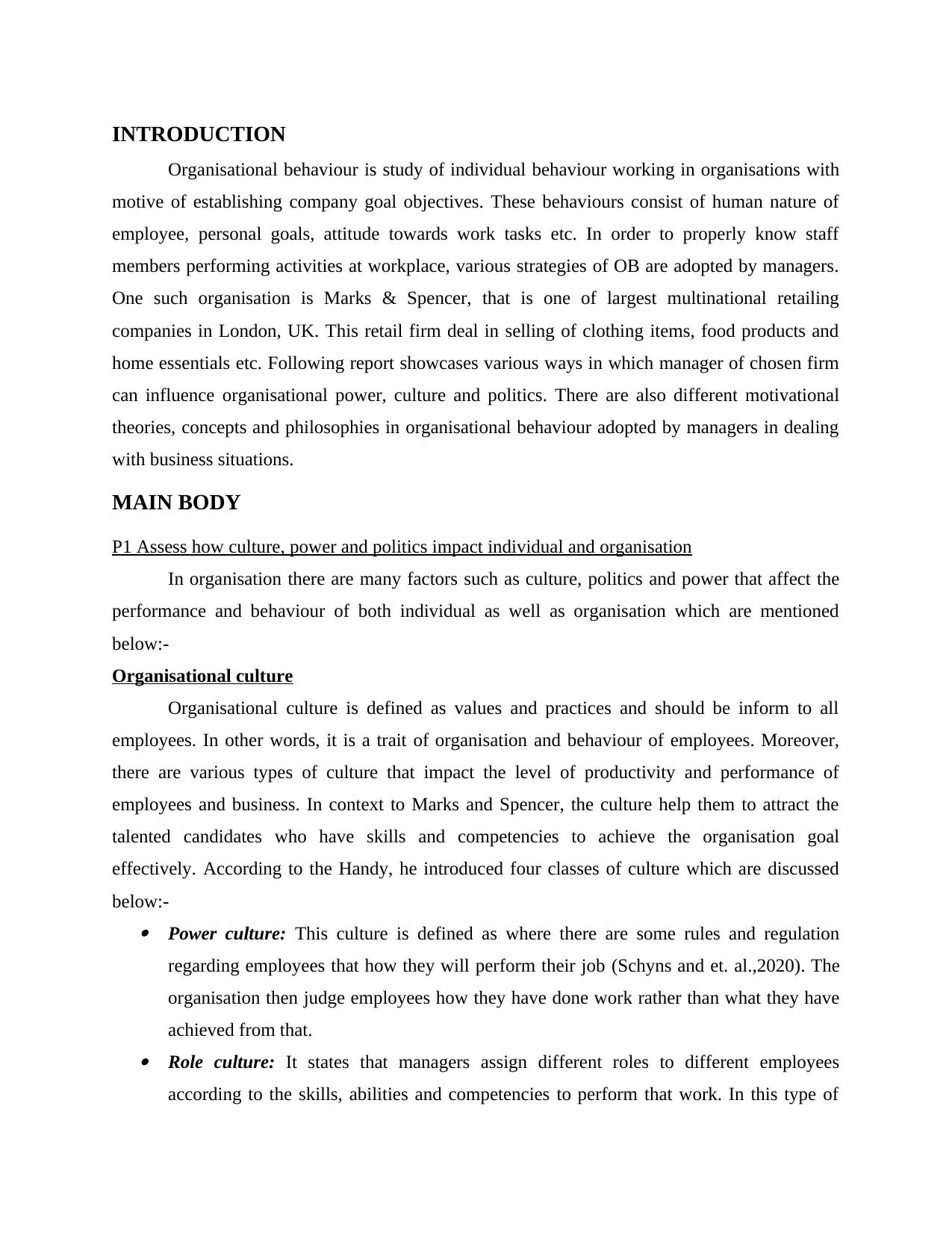
INTRODUCTION
Organisational behaviour is study of individual behaviour working in organisations with
motive of establishing company goal objectives. These behaviours consist of human nature of
employee, personal goals, attitude towards work tasks etc. In order to properly know staff
members performing activities at workplace, various strategies of OB are adopted by managers.
One such organisation is Marks & Spencer, that is one of largest multinational retailing
companies in London, UK. This retail firm deal in selling of clothing items, food products and
home essentials etc. Following report showcases various ways in which manager of chosen firm
can influence organisational power, culture and politics. There are also different motivational
theories, concepts and philosophies in organisational behaviour adopted by managers in dealing
with business situations.
MAIN BODY
P1 Assess how culture, power and politics impact individual and organisation
In organisation there are many factors such as culture, politics and power that affect the
performance and behaviour of both individual as well as organisation which are mentioned
below:-
Organisational culture
Organisational culture is defined as values and practices and should be inform to all
employees. In other words, it is a trait of organisation and behaviour of employees. Moreover,
there are various types of culture that impact the level of productivity and performance of
employees and business. In context to Marks and Spencer, the culture help them to attract the
talented candidates who have skills and competencies to achieve the organisation goal
effectively. According to the Handy, he introduced four classes of culture which are discussed
below:- Power culture: This culture is defined as where there are some rules and regulation
regarding employees that how they will perform their job (Schyns and et. al.,2020). The
organisation then judge employees how they have done work rather than what they have
achieved from that. Role culture: It states that managers assign different roles to different employees
according to the skills, abilities and competencies to perform that work. In this type of
Organisational behaviour is study of individual behaviour working in organisations with
motive of establishing company goal objectives. These behaviours consist of human nature of
employee, personal goals, attitude towards work tasks etc. In order to properly know staff
members performing activities at workplace, various strategies of OB are adopted by managers.
One such organisation is Marks & Spencer, that is one of largest multinational retailing
companies in London, UK. This retail firm deal in selling of clothing items, food products and
home essentials etc. Following report showcases various ways in which manager of chosen firm
can influence organisational power, culture and politics. There are also different motivational
theories, concepts and philosophies in organisational behaviour adopted by managers in dealing
with business situations.
MAIN BODY
P1 Assess how culture, power and politics impact individual and organisation
In organisation there are many factors such as culture, politics and power that affect the
performance and behaviour of both individual as well as organisation which are mentioned
below:-
Organisational culture
Organisational culture is defined as values and practices and should be inform to all
employees. In other words, it is a trait of organisation and behaviour of employees. Moreover,
there are various types of culture that impact the level of productivity and performance of
employees and business. In context to Marks and Spencer, the culture help them to attract the
talented candidates who have skills and competencies to achieve the organisation goal
effectively. According to the Handy, he introduced four classes of culture which are discussed
below:- Power culture: This culture is defined as where there are some rules and regulation
regarding employees that how they will perform their job (Schyns and et. al.,2020). The
organisation then judge employees how they have done work rather than what they have
achieved from that. Role culture: It states that managers assign different roles to different employees
according to the skills, abilities and competencies to perform that work. In this type of
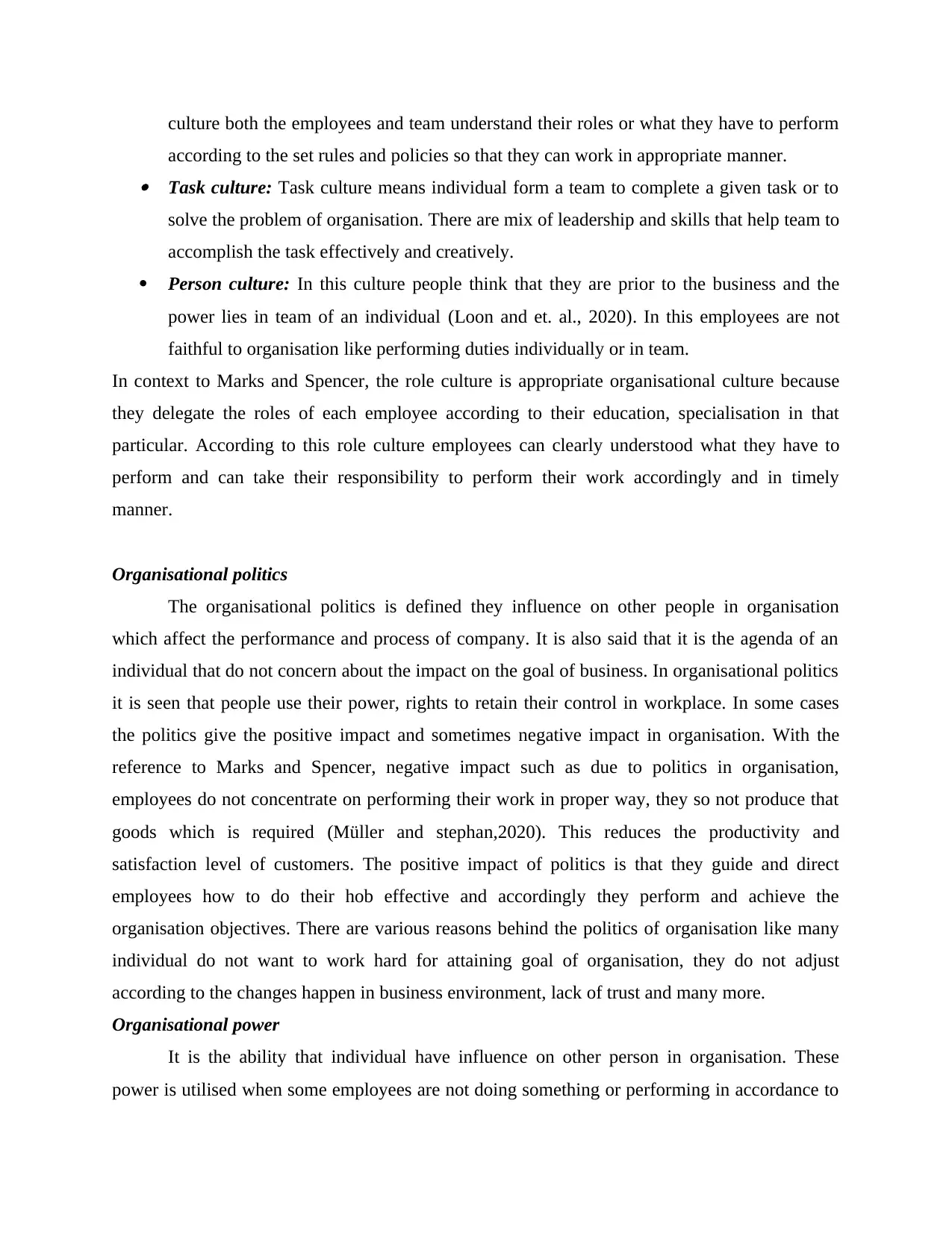
culture both the employees and team understand their roles or what they have to perform
according to the set rules and policies so that they can work in appropriate manner. Task culture: Task culture means individual form a team to complete a given task or to
solve the problem of organisation. There are mix of leadership and skills that help team to
accomplish the task effectively and creatively.
Person culture: In this culture people think that they are prior to the business and the
power lies in team of an individual (Loon and et. al., 2020). In this employees are not
faithful to organisation like performing duties individually or in team.
In context to Marks and Spencer, the role culture is appropriate organisational culture because
they delegate the roles of each employee according to their education, specialisation in that
particular. According to this role culture employees can clearly understood what they have to
perform and can take their responsibility to perform their work accordingly and in timely
manner.
Organisational politics
The organisational politics is defined they influence on other people in organisation
which affect the performance and process of company. It is also said that it is the agenda of an
individual that do not concern about the impact on the goal of business. In organisational politics
it is seen that people use their power, rights to retain their control in workplace. In some cases
the politics give the positive impact and sometimes negative impact in organisation. With the
reference to Marks and Spencer, negative impact such as due to politics in organisation,
employees do not concentrate on performing their work in proper way, they so not produce that
goods which is required (Müller and stephan,2020). This reduces the productivity and
satisfaction level of customers. The positive impact of politics is that they guide and direct
employees how to do their hob effective and accordingly they perform and achieve the
organisation objectives. There are various reasons behind the politics of organisation like many
individual do not want to work hard for attaining goal of organisation, they do not adjust
according to the changes happen in business environment, lack of trust and many more.
Organisational power
It is the ability that individual have influence on other person in organisation. These
power is utilised when some employees are not doing something or performing in accordance to
according to the set rules and policies so that they can work in appropriate manner. Task culture: Task culture means individual form a team to complete a given task or to
solve the problem of organisation. There are mix of leadership and skills that help team to
accomplish the task effectively and creatively.
Person culture: In this culture people think that they are prior to the business and the
power lies in team of an individual (Loon and et. al., 2020). In this employees are not
faithful to organisation like performing duties individually or in team.
In context to Marks and Spencer, the role culture is appropriate organisational culture because
they delegate the roles of each employee according to their education, specialisation in that
particular. According to this role culture employees can clearly understood what they have to
perform and can take their responsibility to perform their work accordingly and in timely
manner.
Organisational politics
The organisational politics is defined they influence on other people in organisation
which affect the performance and process of company. It is also said that it is the agenda of an
individual that do not concern about the impact on the goal of business. In organisational politics
it is seen that people use their power, rights to retain their control in workplace. In some cases
the politics give the positive impact and sometimes negative impact in organisation. With the
reference to Marks and Spencer, negative impact such as due to politics in organisation,
employees do not concentrate on performing their work in proper way, they so not produce that
goods which is required (Müller and stephan,2020). This reduces the productivity and
satisfaction level of customers. The positive impact of politics is that they guide and direct
employees how to do their hob effective and accordingly they perform and achieve the
organisation objectives. There are various reasons behind the politics of organisation like many
individual do not want to work hard for attaining goal of organisation, they do not adjust
according to the changes happen in business environment, lack of trust and many more.
Organisational power
It is the ability that individual have influence on other person in organisation. These
power is utilised when some employees are not doing something or performing in accordance to
Secure Best Marks with AI Grader
Need help grading? Try our AI Grader for instant feedback on your assignments.
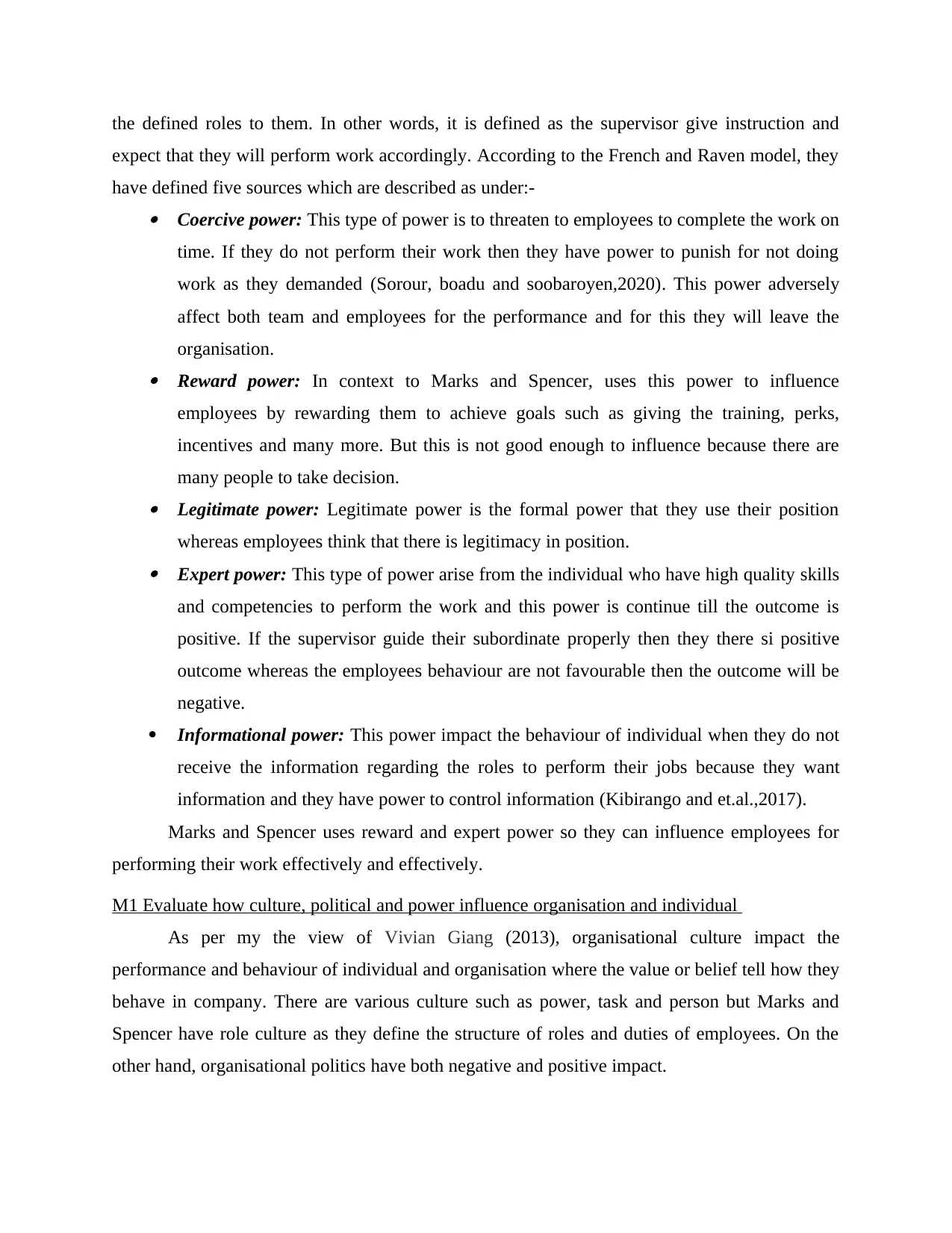
the defined roles to them. In other words, it is defined as the supervisor give instruction and
expect that they will perform work accordingly. According to the French and Raven model, they
have defined five sources which are described as under:- Coercive power: This type of power is to threaten to employees to complete the work on
time. If they do not perform their work then they have power to punish for not doing
work as they demanded (Sorour, boadu and soobaroyen,2020). This power adversely
affect both team and employees for the performance and for this they will leave the
organisation. Reward power: In context to Marks and Spencer, uses this power to influence
employees by rewarding them to achieve goals such as giving the training, perks,
incentives and many more. But this is not good enough to influence because there are
many people to take decision. Legitimate power: Legitimate power is the formal power that they use their position
whereas employees think that there is legitimacy in position. Expert power: This type of power arise from the individual who have high quality skills
and competencies to perform the work and this power is continue till the outcome is
positive. If the supervisor guide their subordinate properly then they there si positive
outcome whereas the employees behaviour are not favourable then the outcome will be
negative.
Informational power: This power impact the behaviour of individual when they do not
receive the information regarding the roles to perform their jobs because they want
information and they have power to control information (Kibirango and et.al.,2017).
Marks and Spencer uses reward and expert power so they can influence employees for
performing their work effectively and effectively.
M1 Evaluate how culture, political and power influence organisation and individual
As per my the view of Vivian Giang (2013), organisational culture impact the
performance and behaviour of individual and organisation where the value or belief tell how they
behave in company. There are various culture such as power, task and person but Marks and
Spencer have role culture as they define the structure of roles and duties of employees. On the
other hand, organisational politics have both negative and positive impact.
expect that they will perform work accordingly. According to the French and Raven model, they
have defined five sources which are described as under:- Coercive power: This type of power is to threaten to employees to complete the work on
time. If they do not perform their work then they have power to punish for not doing
work as they demanded (Sorour, boadu and soobaroyen,2020). This power adversely
affect both team and employees for the performance and for this they will leave the
organisation. Reward power: In context to Marks and Spencer, uses this power to influence
employees by rewarding them to achieve goals such as giving the training, perks,
incentives and many more. But this is not good enough to influence because there are
many people to take decision. Legitimate power: Legitimate power is the formal power that they use their position
whereas employees think that there is legitimacy in position. Expert power: This type of power arise from the individual who have high quality skills
and competencies to perform the work and this power is continue till the outcome is
positive. If the supervisor guide their subordinate properly then they there si positive
outcome whereas the employees behaviour are not favourable then the outcome will be
negative.
Informational power: This power impact the behaviour of individual when they do not
receive the information regarding the roles to perform their jobs because they want
information and they have power to control information (Kibirango and et.al.,2017).
Marks and Spencer uses reward and expert power so they can influence employees for
performing their work effectively and effectively.
M1 Evaluate how culture, political and power influence organisation and individual
As per my the view of Vivian Giang (2013), organisational culture impact the
performance and behaviour of individual and organisation where the value or belief tell how they
behave in company. There are various culture such as power, task and person but Marks and
Spencer have role culture as they define the structure of roles and duties of employees. On the
other hand, organisational politics have both negative and positive impact.
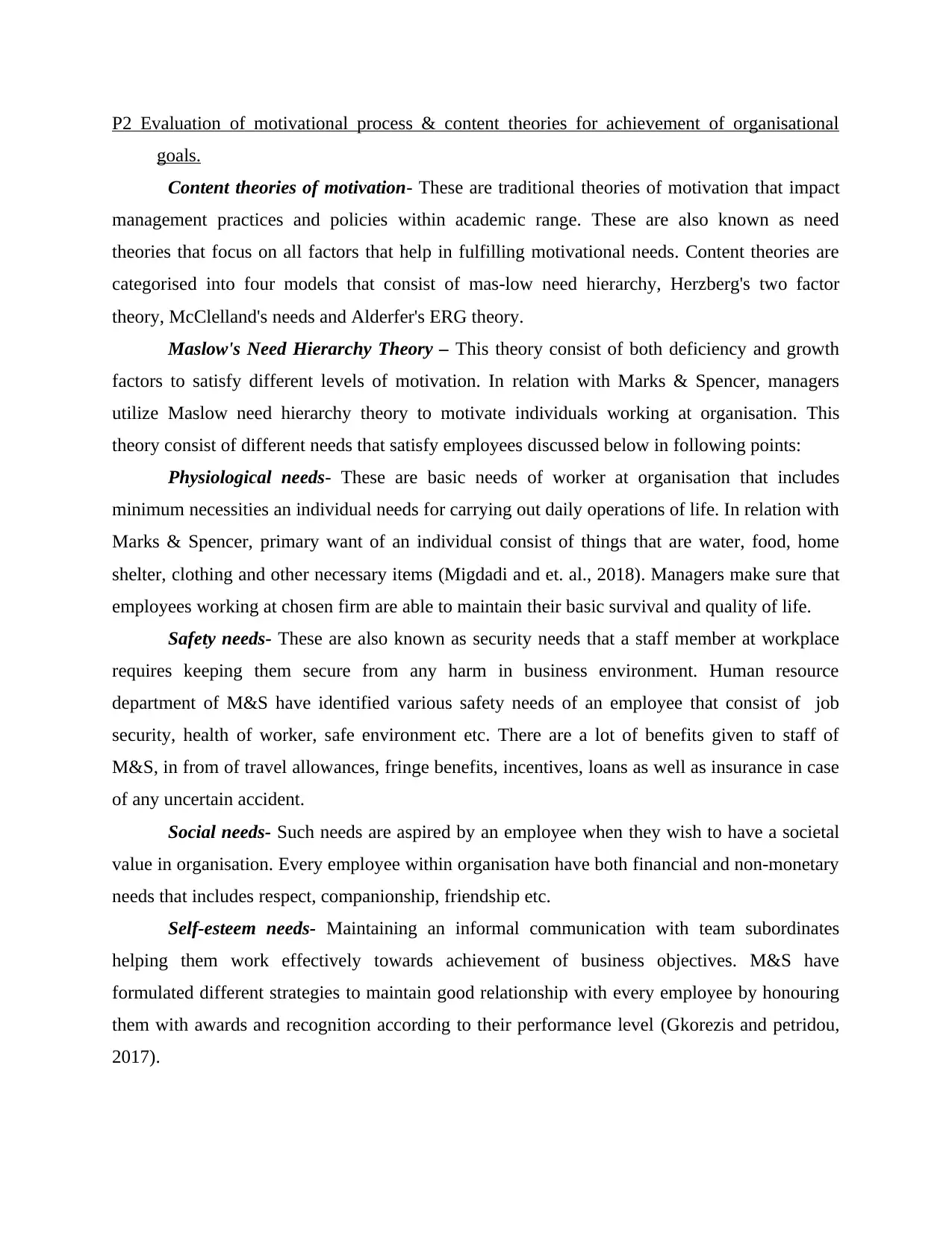
P2 Evaluation of motivational process & content theories for achievement of organisational
goals.
Content theories of motivation- These are traditional theories of motivation that impact
management practices and policies within academic range. These are also known as need
theories that focus on all factors that help in fulfilling motivational needs. Content theories are
categorised into four models that consist of mas-low need hierarchy, Herzberg's two factor
theory, McClelland's needs and Alderfer's ERG theory.
Maslow's Need Hierarchy Theory – This theory consist of both deficiency and growth
factors to satisfy different levels of motivation. In relation with Marks & Spencer, managers
utilize Maslow need hierarchy theory to motivate individuals working at organisation. This
theory consist of different needs that satisfy employees discussed below in following points:
Physiological needs- These are basic needs of worker at organisation that includes
minimum necessities an individual needs for carrying out daily operations of life. In relation with
Marks & Spencer, primary want of an individual consist of things that are water, food, home
shelter, clothing and other necessary items (Migdadi and et. al., 2018). Managers make sure that
employees working at chosen firm are able to maintain their basic survival and quality of life.
Safety needs- These are also known as security needs that a staff member at workplace
requires keeping them secure from any harm in business environment. Human resource
department of M&S have identified various safety needs of an employee that consist of job
security, health of worker, safe environment etc. There are a lot of benefits given to staff of
M&S, in from of travel allowances, fringe benefits, incentives, loans as well as insurance in case
of any uncertain accident.
Social needs- Such needs are aspired by an employee when they wish to have a societal
value in organisation. Every employee within organisation have both financial and non-monetary
needs that includes respect, companionship, friendship etc.
Self-esteem needs- Maintaining an informal communication with team subordinates
helping them work effectively towards achievement of business objectives. M&S have
formulated different strategies to maintain good relationship with every employee by honouring
them with awards and recognition according to their performance level (Gkorezis and petridou,
2017).
goals.
Content theories of motivation- These are traditional theories of motivation that impact
management practices and policies within academic range. These are also known as need
theories that focus on all factors that help in fulfilling motivational needs. Content theories are
categorised into four models that consist of mas-low need hierarchy, Herzberg's two factor
theory, McClelland's needs and Alderfer's ERG theory.
Maslow's Need Hierarchy Theory – This theory consist of both deficiency and growth
factors to satisfy different levels of motivation. In relation with Marks & Spencer, managers
utilize Maslow need hierarchy theory to motivate individuals working at organisation. This
theory consist of different needs that satisfy employees discussed below in following points:
Physiological needs- These are basic needs of worker at organisation that includes
minimum necessities an individual needs for carrying out daily operations of life. In relation with
Marks & Spencer, primary want of an individual consist of things that are water, food, home
shelter, clothing and other necessary items (Migdadi and et. al., 2018). Managers make sure that
employees working at chosen firm are able to maintain their basic survival and quality of life.
Safety needs- These are also known as security needs that a staff member at workplace
requires keeping them secure from any harm in business environment. Human resource
department of M&S have identified various safety needs of an employee that consist of job
security, health of worker, safe environment etc. There are a lot of benefits given to staff of
M&S, in from of travel allowances, fringe benefits, incentives, loans as well as insurance in case
of any uncertain accident.
Social needs- Such needs are aspired by an employee when they wish to have a societal
value in organisation. Every employee within organisation have both financial and non-monetary
needs that includes respect, companionship, friendship etc.
Self-esteem needs- Maintaining an informal communication with team subordinates
helping them work effectively towards achievement of business objectives. M&S have
formulated different strategies to maintain good relationship with every employee by honouring
them with awards and recognition according to their performance level (Gkorezis and petridou,
2017).
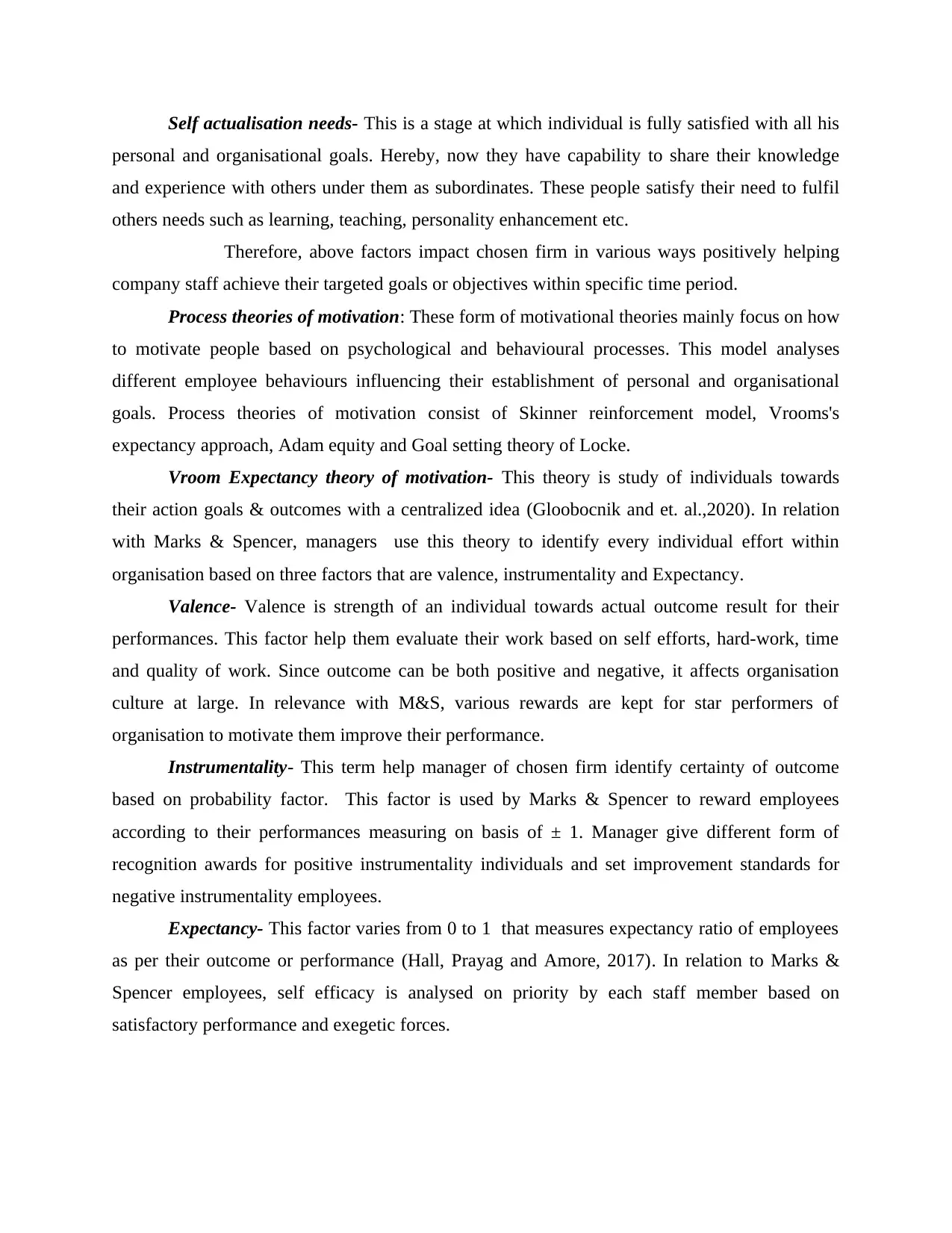
Self actualisation needs- This is a stage at which individual is fully satisfied with all his
personal and organisational goals. Hereby, now they have capability to share their knowledge
and experience with others under them as subordinates. These people satisfy their need to fulfil
others needs such as learning, teaching, personality enhancement etc.
Therefore, above factors impact chosen firm in various ways positively helping
company staff achieve their targeted goals or objectives within specific time period.
Process theories of motivation: These form of motivational theories mainly focus on how
to motivate people based on psychological and behavioural processes. This model analyses
different employee behaviours influencing their establishment of personal and organisational
goals. Process theories of motivation consist of Skinner reinforcement model, Vrooms's
expectancy approach, Adam equity and Goal setting theory of Locke.
Vroom Expectancy theory of motivation- This theory is study of individuals towards
their action goals & outcomes with a centralized idea (Gloobocnik and et. al.,2020). In relation
with Marks & Spencer, managers use this theory to identify every individual effort within
organisation based on three factors that are valence, instrumentality and Expectancy.
Valence- Valence is strength of an individual towards actual outcome result for their
performances. This factor help them evaluate their work based on self efforts, hard-work, time
and quality of work. Since outcome can be both positive and negative, it affects organisation
culture at large. In relevance with M&S, various rewards are kept for star performers of
organisation to motivate them improve their performance.
Instrumentality- This term help manager of chosen firm identify certainty of outcome
based on probability factor. This factor is used by Marks & Spencer to reward employees
according to their performances measuring on basis of ± 1. Manager give different form of
recognition awards for positive instrumentality individuals and set improvement standards for
negative instrumentality employees.
Expectancy- This factor varies from 0 to 1 that measures expectancy ratio of employees
as per their outcome or performance (Hall, Prayag and Amore, 2017). In relation to Marks &
Spencer employees, self efficacy is analysed on priority by each staff member based on
satisfactory performance and exegetic forces.
personal and organisational goals. Hereby, now they have capability to share their knowledge
and experience with others under them as subordinates. These people satisfy their need to fulfil
others needs such as learning, teaching, personality enhancement etc.
Therefore, above factors impact chosen firm in various ways positively helping
company staff achieve their targeted goals or objectives within specific time period.
Process theories of motivation: These form of motivational theories mainly focus on how
to motivate people based on psychological and behavioural processes. This model analyses
different employee behaviours influencing their establishment of personal and organisational
goals. Process theories of motivation consist of Skinner reinforcement model, Vrooms's
expectancy approach, Adam equity and Goal setting theory of Locke.
Vroom Expectancy theory of motivation- This theory is study of individuals towards
their action goals & outcomes with a centralized idea (Gloobocnik and et. al.,2020). In relation
with Marks & Spencer, managers use this theory to identify every individual effort within
organisation based on three factors that are valence, instrumentality and Expectancy.
Valence- Valence is strength of an individual towards actual outcome result for their
performances. This factor help them evaluate their work based on self efforts, hard-work, time
and quality of work. Since outcome can be both positive and negative, it affects organisation
culture at large. In relevance with M&S, various rewards are kept for star performers of
organisation to motivate them improve their performance.
Instrumentality- This term help manager of chosen firm identify certainty of outcome
based on probability factor. This factor is used by Marks & Spencer to reward employees
according to their performances measuring on basis of ± 1. Manager give different form of
recognition awards for positive instrumentality individuals and set improvement standards for
negative instrumentality employees.
Expectancy- This factor varies from 0 to 1 that measures expectancy ratio of employees
as per their outcome or performance (Hall, Prayag and Amore, 2017). In relation to Marks &
Spencer employees, self efficacy is analysed on priority by each staff member based on
satisfactory performance and exegetic forces.
Paraphrase This Document
Need a fresh take? Get an instant paraphrase of this document with our AI Paraphraser
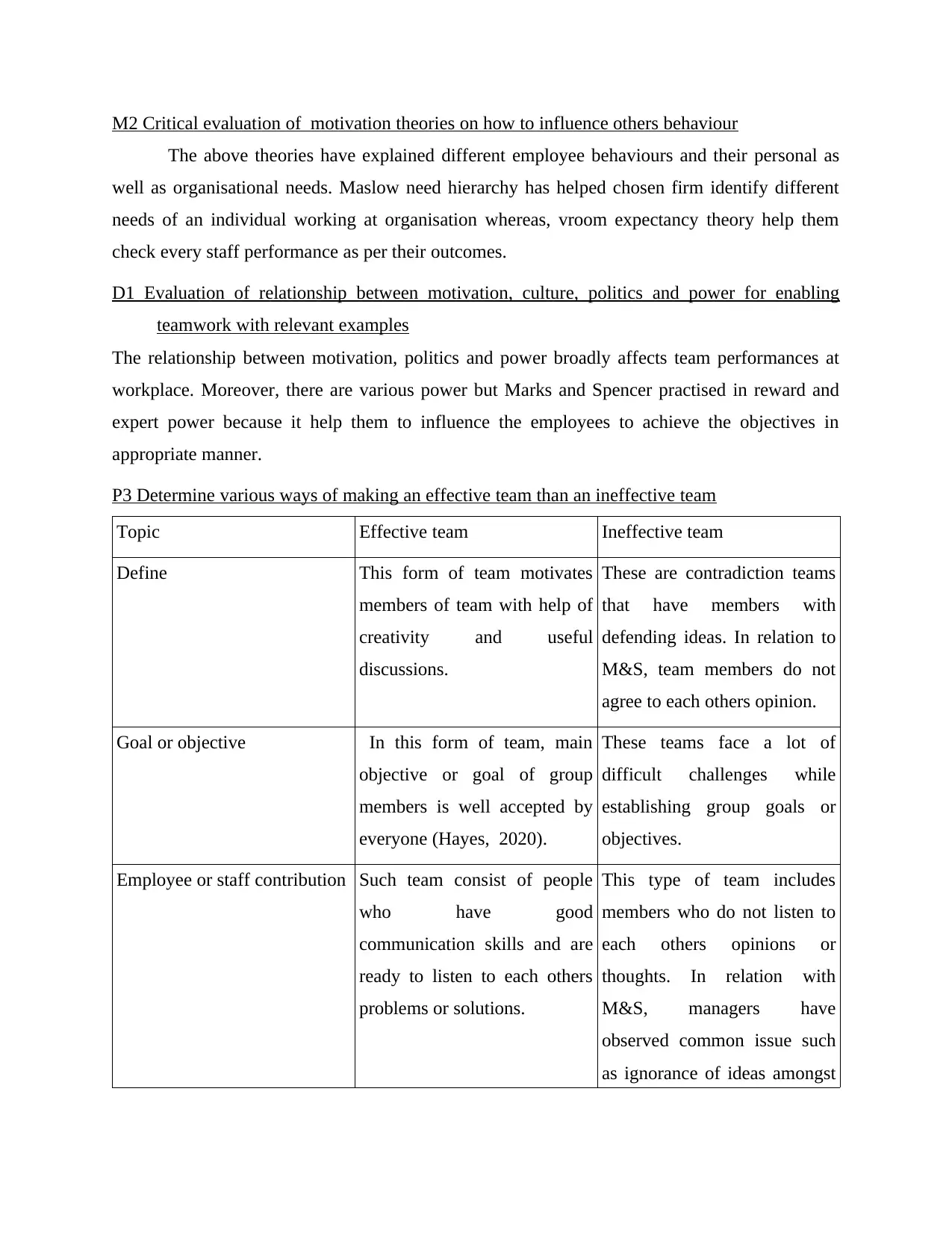
M2 Critical evaluation of motivation theories on how to influence others behaviour
The above theories have explained different employee behaviours and their personal as
well as organisational needs. Maslow need hierarchy has helped chosen firm identify different
needs of an individual working at organisation whereas, vroom expectancy theory help them
check every staff performance as per their outcomes.
D1 Evaluation of relationship between motivation, culture, politics and power for enabling
teamwork with relevant examples
The relationship between motivation, politics and power broadly affects team performances at
workplace. Moreover, there are various power but Marks and Spencer practised in reward and
expert power because it help them to influence the employees to achieve the objectives in
appropriate manner.
P3 Determine various ways of making an effective team than an ineffective team
Topic Effective team Ineffective team
Define This form of team motivates
members of team with help of
creativity and useful
discussions.
These are contradiction teams
that have members with
defending ideas. In relation to
M&S, team members do not
agree to each others opinion.
Goal or objective In this form of team, main
objective or goal of group
members is well accepted by
everyone (Hayes, 2020).
These teams face a lot of
difficult challenges while
establishing group goals or
objectives.
Employee or staff contribution Such team consist of people
who have good
communication skills and are
ready to listen to each others
problems or solutions.
This type of team includes
members who do not listen to
each others opinions or
thoughts. In relation with
M&S, managers have
observed common issue such
as ignorance of ideas amongst
The above theories have explained different employee behaviours and their personal as
well as organisational needs. Maslow need hierarchy has helped chosen firm identify different
needs of an individual working at organisation whereas, vroom expectancy theory help them
check every staff performance as per their outcomes.
D1 Evaluation of relationship between motivation, culture, politics and power for enabling
teamwork with relevant examples
The relationship between motivation, politics and power broadly affects team performances at
workplace. Moreover, there are various power but Marks and Spencer practised in reward and
expert power because it help them to influence the employees to achieve the objectives in
appropriate manner.
P3 Determine various ways of making an effective team than an ineffective team
Topic Effective team Ineffective team
Define This form of team motivates
members of team with help of
creativity and useful
discussions.
These are contradiction teams
that have members with
defending ideas. In relation to
M&S, team members do not
agree to each others opinion.
Goal or objective In this form of team, main
objective or goal of group
members is well accepted by
everyone (Hayes, 2020).
These teams face a lot of
difficult challenges while
establishing group goals or
objectives.
Employee or staff contribution Such team consist of people
who have good
communication skills and are
ready to listen to each others
problems or solutions.
This type of team includes
members who do not listen to
each others opinions or
thoughts. In relation with
M&S, managers have
observed common issue such
as ignorance of ideas amongst
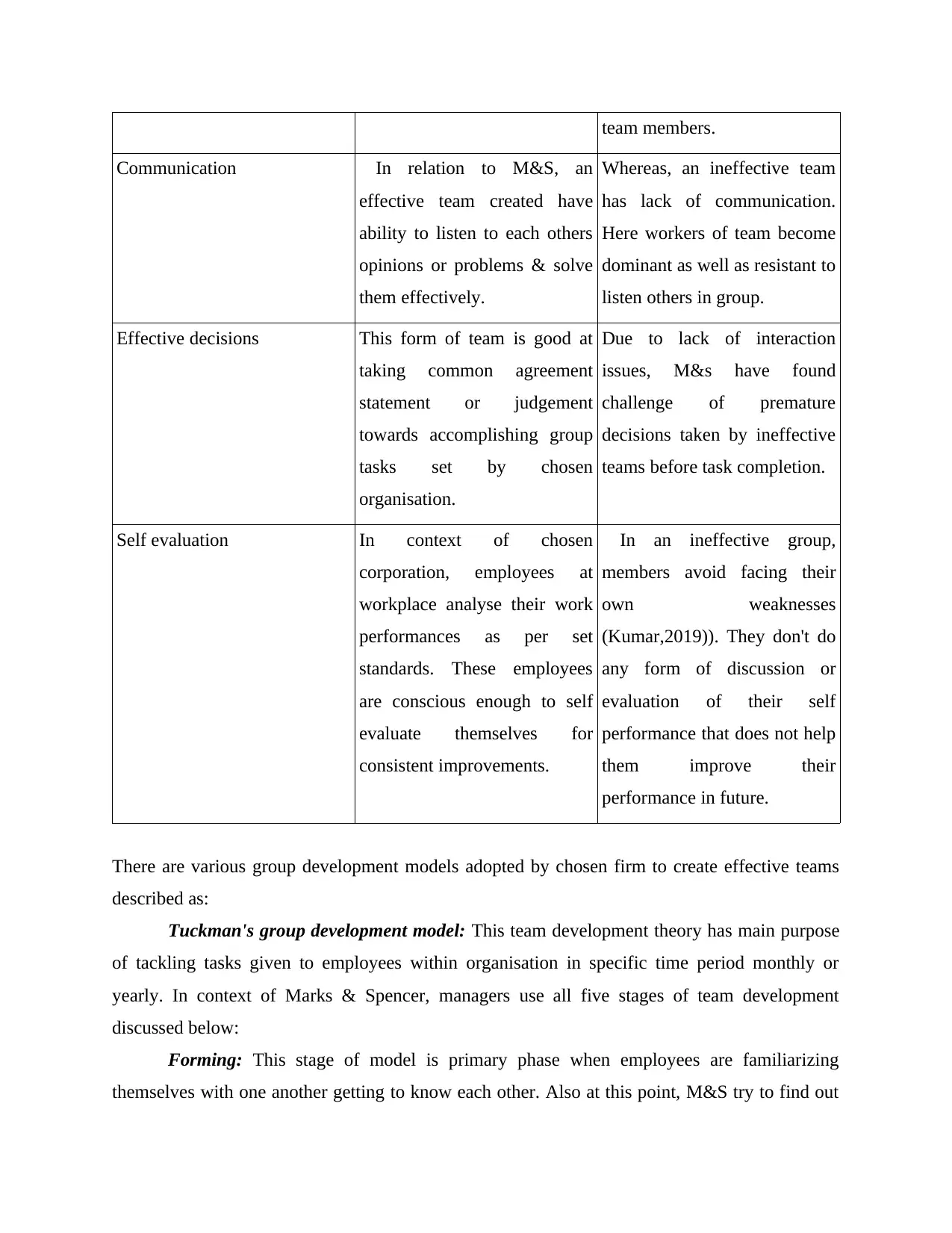
team members.
Communication In relation to M&S, an
effective team created have
ability to listen to each others
opinions or problems & solve
them effectively.
Whereas, an ineffective team
has lack of communication.
Here workers of team become
dominant as well as resistant to
listen others in group.
Effective decisions This form of team is good at
taking common agreement
statement or judgement
towards accomplishing group
tasks set by chosen
organisation.
Due to lack of interaction
issues, M&s have found
challenge of premature
decisions taken by ineffective
teams before task completion.
Self evaluation In context of chosen
corporation, employees at
workplace analyse their work
performances as per set
standards. These employees
are conscious enough to self
evaluate themselves for
consistent improvements.
In an ineffective group,
members avoid facing their
own weaknesses
(Kumar,2019)). They don't do
any form of discussion or
evaluation of their self
performance that does not help
them improve their
performance in future.
There are various group development models adopted by chosen firm to create effective teams
described as:
Tuckman's group development model: This team development theory has main purpose
of tackling tasks given to employees within organisation in specific time period monthly or
yearly. In context of Marks & Spencer, managers use all five stages of team development
discussed below:
Forming: This stage of model is primary phase when employees are familiarizing
themselves with one another getting to know each other. Also at this point, M&S try to find out
Communication In relation to M&S, an
effective team created have
ability to listen to each others
opinions or problems & solve
them effectively.
Whereas, an ineffective team
has lack of communication.
Here workers of team become
dominant as well as resistant to
listen others in group.
Effective decisions This form of team is good at
taking common agreement
statement or judgement
towards accomplishing group
tasks set by chosen
organisation.
Due to lack of interaction
issues, M&s have found
challenge of premature
decisions taken by ineffective
teams before task completion.
Self evaluation In context of chosen
corporation, employees at
workplace analyse their work
performances as per set
standards. These employees
are conscious enough to self
evaluate themselves for
consistent improvements.
In an ineffective group,
members avoid facing their
own weaknesses
(Kumar,2019)). They don't do
any form of discussion or
evaluation of their self
performance that does not help
them improve their
performance in future.
There are various group development models adopted by chosen firm to create effective teams
described as:
Tuckman's group development model: This team development theory has main purpose
of tackling tasks given to employees within organisation in specific time period monthly or
yearly. In context of Marks & Spencer, managers use all five stages of team development
discussed below:
Forming: This stage of model is primary phase when employees are familiarizing
themselves with one another getting to know each other. Also at this point, M&S try to find out
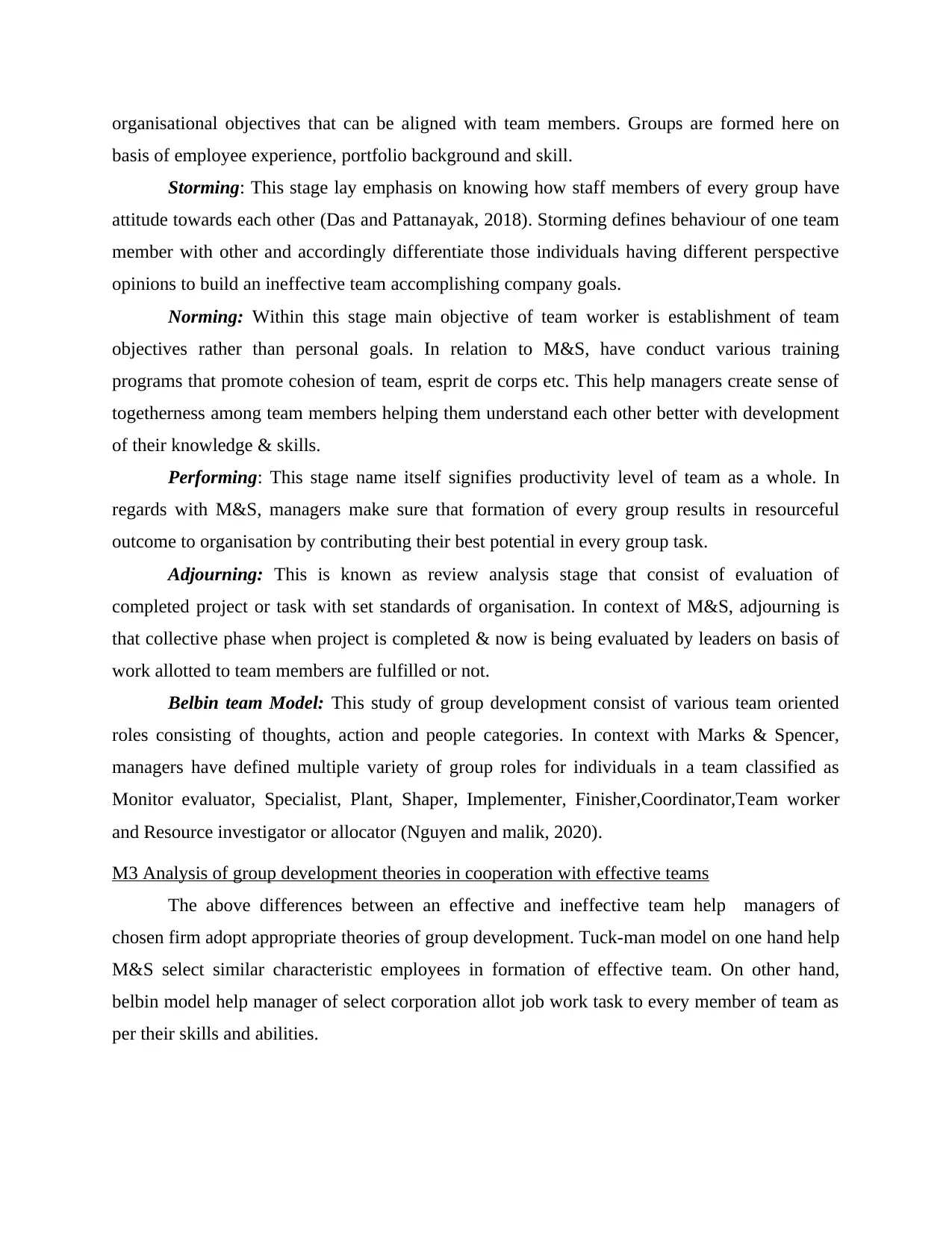
organisational objectives that can be aligned with team members. Groups are formed here on
basis of employee experience, portfolio background and skill.
Storming: This stage lay emphasis on knowing how staff members of every group have
attitude towards each other (Das and Pattanayak, 2018). Storming defines behaviour of one team
member with other and accordingly differentiate those individuals having different perspective
opinions to build an ineffective team accomplishing company goals.
Norming: Within this stage main objective of team worker is establishment of team
objectives rather than personal goals. In relation to M&S, have conduct various training
programs that promote cohesion of team, esprit de corps etc. This help managers create sense of
togetherness among team members helping them understand each other better with development
of their knowledge & skills.
Performing: This stage name itself signifies productivity level of team as a whole. In
regards with M&S, managers make sure that formation of every group results in resourceful
outcome to organisation by contributing their best potential in every group task.
Adjourning: This is known as review analysis stage that consist of evaluation of
completed project or task with set standards of organisation. In context of M&S, adjourning is
that collective phase when project is completed & now is being evaluated by leaders on basis of
work allotted to team members are fulfilled or not.
Belbin team Model: This study of group development consist of various team oriented
roles consisting of thoughts, action and people categories. In context with Marks & Spencer,
managers have defined multiple variety of group roles for individuals in a team classified as
Monitor evaluator, Specialist, Plant, Shaper, Implementer, Finisher,Coordinator,Team worker
and Resource investigator or allocator (Nguyen and malik, 2020).
M3 Analysis of group development theories in cooperation with effective teams
The above differences between an effective and ineffective team help managers of
chosen firm adopt appropriate theories of group development. Tuck-man model on one hand help
M&S select similar characteristic employees in formation of effective team. On other hand,
belbin model help manager of select corporation allot job work task to every member of team as
per their skills and abilities.
basis of employee experience, portfolio background and skill.
Storming: This stage lay emphasis on knowing how staff members of every group have
attitude towards each other (Das and Pattanayak, 2018). Storming defines behaviour of one team
member with other and accordingly differentiate those individuals having different perspective
opinions to build an ineffective team accomplishing company goals.
Norming: Within this stage main objective of team worker is establishment of team
objectives rather than personal goals. In relation to M&S, have conduct various training
programs that promote cohesion of team, esprit de corps etc. This help managers create sense of
togetherness among team members helping them understand each other better with development
of their knowledge & skills.
Performing: This stage name itself signifies productivity level of team as a whole. In
regards with M&S, managers make sure that formation of every group results in resourceful
outcome to organisation by contributing their best potential in every group task.
Adjourning: This is known as review analysis stage that consist of evaluation of
completed project or task with set standards of organisation. In context of M&S, adjourning is
that collective phase when project is completed & now is being evaluated by leaders on basis of
work allotted to team members are fulfilled or not.
Belbin team Model: This study of group development consist of various team oriented
roles consisting of thoughts, action and people categories. In context with Marks & Spencer,
managers have defined multiple variety of group roles for individuals in a team classified as
Monitor evaluator, Specialist, Plant, Shaper, Implementer, Finisher,Coordinator,Team worker
and Resource investigator or allocator (Nguyen and malik, 2020).
M3 Analysis of group development theories in cooperation with effective teams
The above differences between an effective and ineffective team help managers of
chosen firm adopt appropriate theories of group development. Tuck-man model on one hand help
M&S select similar characteristic employees in formation of effective team. On other hand,
belbin model help manager of select corporation allot job work task to every member of team as
per their skills and abilities.
Secure Best Marks with AI Grader
Need help grading? Try our AI Grader for instant feedback on your assignments.
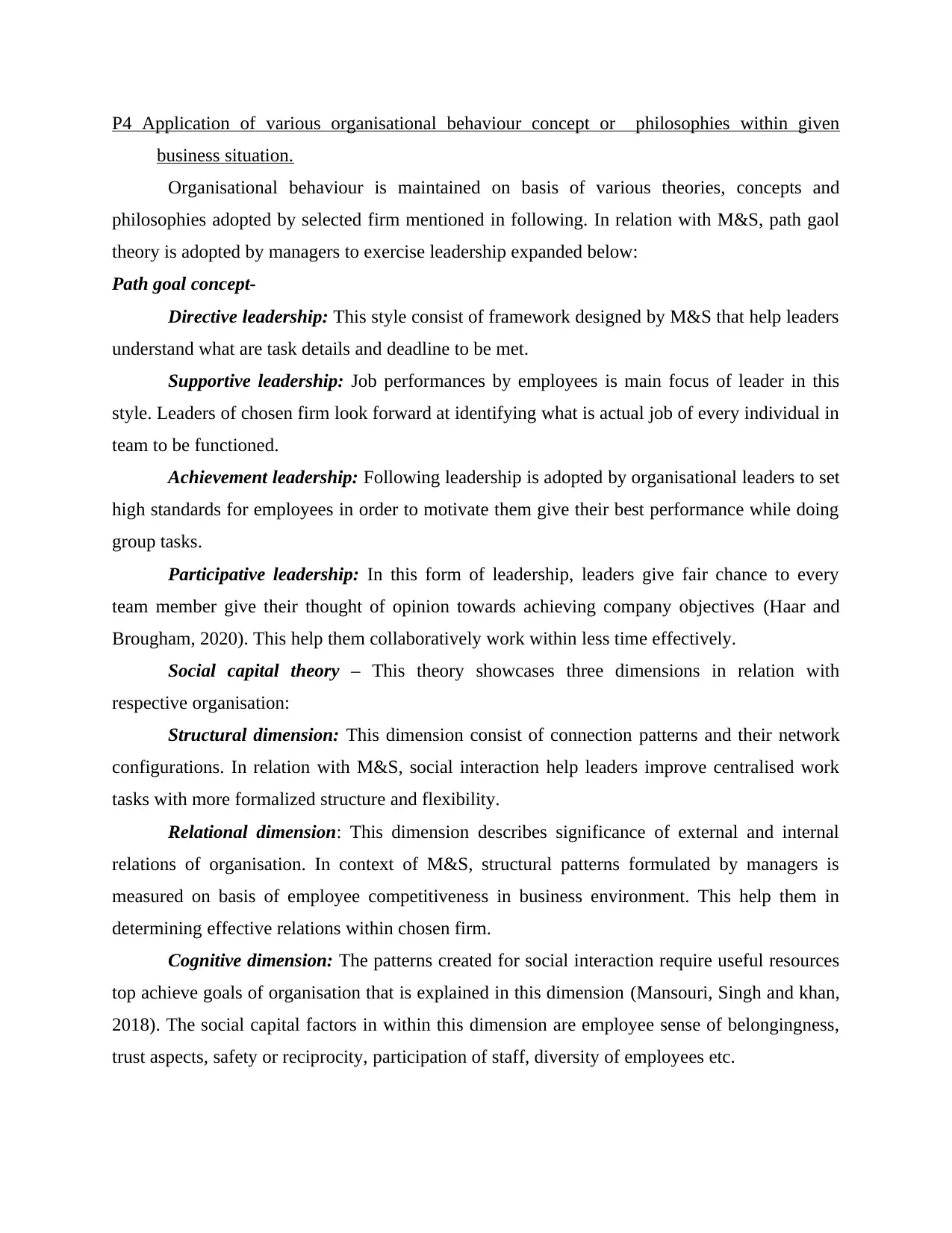
P4 Application of various organisational behaviour concept or philosophies within given
business situation.
Organisational behaviour is maintained on basis of various theories, concepts and
philosophies adopted by selected firm mentioned in following. In relation with M&S, path gaol
theory is adopted by managers to exercise leadership expanded below:
Path goal concept-
Directive leadership: This style consist of framework designed by M&S that help leaders
understand what are task details and deadline to be met.
Supportive leadership: Job performances by employees is main focus of leader in this
style. Leaders of chosen firm look forward at identifying what is actual job of every individual in
team to be functioned.
Achievement leadership: Following leadership is adopted by organisational leaders to set
high standards for employees in order to motivate them give their best performance while doing
group tasks.
Participative leadership: In this form of leadership, leaders give fair chance to every
team member give their thought of opinion towards achieving company objectives (Haar and
Brougham, 2020). This help them collaboratively work within less time effectively.
Social capital theory – This theory showcases three dimensions in relation with
respective organisation:
Structural dimension: This dimension consist of connection patterns and their network
configurations. In relation with M&S, social interaction help leaders improve centralised work
tasks with more formalized structure and flexibility.
Relational dimension: This dimension describes significance of external and internal
relations of organisation. In context of M&S, structural patterns formulated by managers is
measured on basis of employee competitiveness in business environment. This help them in
determining effective relations within chosen firm.
Cognitive dimension: The patterns created for social interaction require useful resources
top achieve goals of organisation that is explained in this dimension (Mansouri, Singh and khan,
2018). The social capital factors in within this dimension are employee sense of belongingness,
trust aspects, safety or reciprocity, participation of staff, diversity of employees etc.
business situation.
Organisational behaviour is maintained on basis of various theories, concepts and
philosophies adopted by selected firm mentioned in following. In relation with M&S, path gaol
theory is adopted by managers to exercise leadership expanded below:
Path goal concept-
Directive leadership: This style consist of framework designed by M&S that help leaders
understand what are task details and deadline to be met.
Supportive leadership: Job performances by employees is main focus of leader in this
style. Leaders of chosen firm look forward at identifying what is actual job of every individual in
team to be functioned.
Achievement leadership: Following leadership is adopted by organisational leaders to set
high standards for employees in order to motivate them give their best performance while doing
group tasks.
Participative leadership: In this form of leadership, leaders give fair chance to every
team member give their thought of opinion towards achieving company objectives (Haar and
Brougham, 2020). This help them collaboratively work within less time effectively.
Social capital theory – This theory showcases three dimensions in relation with
respective organisation:
Structural dimension: This dimension consist of connection patterns and their network
configurations. In relation with M&S, social interaction help leaders improve centralised work
tasks with more formalized structure and flexibility.
Relational dimension: This dimension describes significance of external and internal
relations of organisation. In context of M&S, structural patterns formulated by managers is
measured on basis of employee competitiveness in business environment. This help them in
determining effective relations within chosen firm.
Cognitive dimension: The patterns created for social interaction require useful resources
top achieve goals of organisation that is explained in this dimension (Mansouri, Singh and khan,
2018). The social capital factors in within this dimension are employee sense of belongingness,
trust aspects, safety or reciprocity, participation of staff, diversity of employees etc.
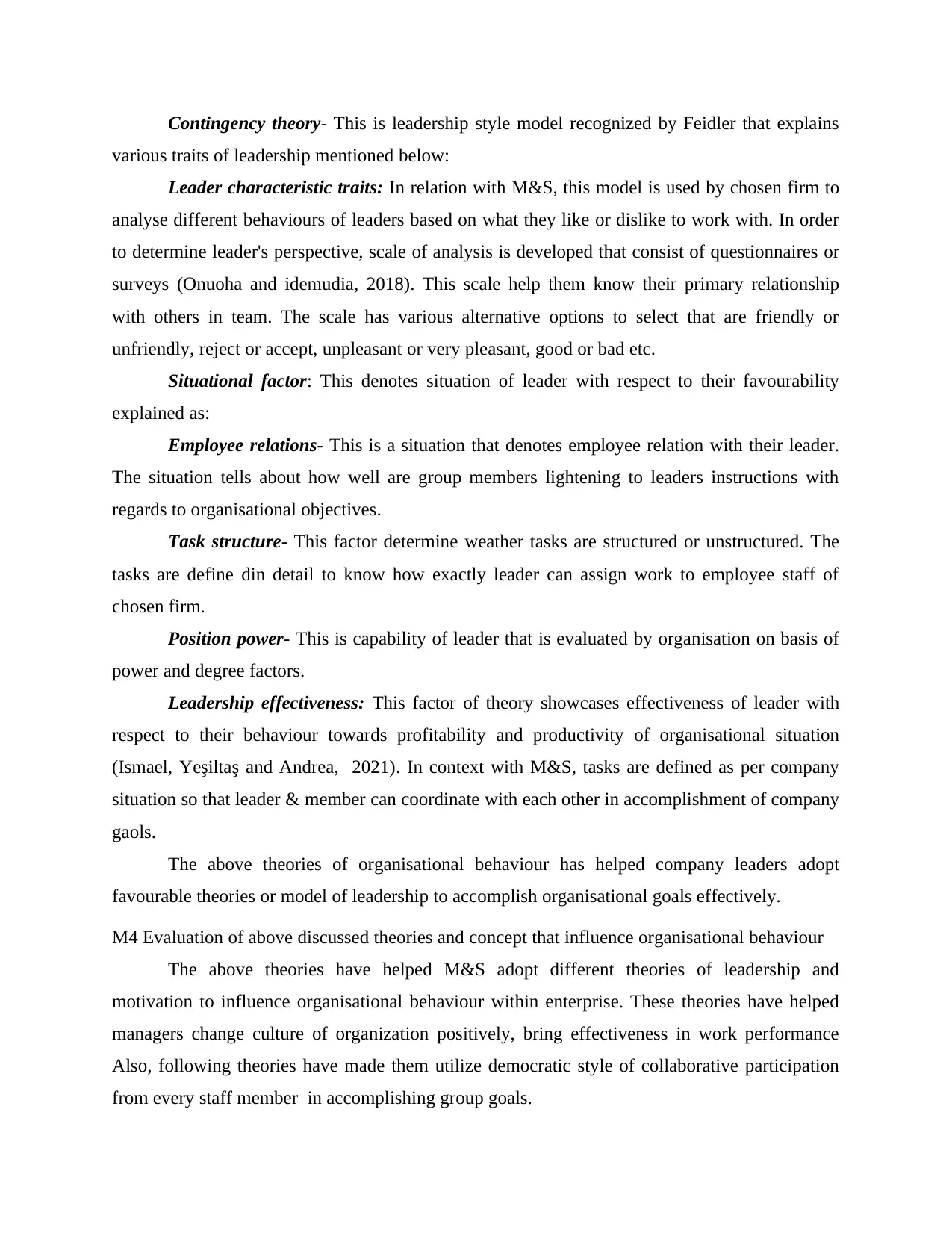
Contingency theory- This is leadership style model recognized by Feidler that explains
various traits of leadership mentioned below:
Leader characteristic traits: In relation with M&S, this model is used by chosen firm to
analyse different behaviours of leaders based on what they like or dislike to work with. In order
to determine leader's perspective, scale of analysis is developed that consist of questionnaires or
surveys (Onuoha and idemudia, 2018). This scale help them know their primary relationship
with others in team. The scale has various alternative options to select that are friendly or
unfriendly, reject or accept, unpleasant or very pleasant, good or bad etc.
Situational factor: This denotes situation of leader with respect to their favourability
explained as:
Employee relations- This is a situation that denotes employee relation with their leader.
The situation tells about how well are group members lightening to leaders instructions with
regards to organisational objectives.
Task structure- This factor determine weather tasks are structured or unstructured. The
tasks are define din detail to know how exactly leader can assign work to employee staff of
chosen firm.
Position power- This is capability of leader that is evaluated by organisation on basis of
power and degree factors.
Leadership effectiveness: This factor of theory showcases effectiveness of leader with
respect to their behaviour towards profitability and productivity of organisational situation
(Ismael, Yeşiltaş and Andrea, 2021). In context with M&S, tasks are defined as per company
situation so that leader & member can coordinate with each other in accomplishment of company
gaols.
The above theories of organisational behaviour has helped company leaders adopt
favourable theories or model of leadership to accomplish organisational goals effectively.
M4 Evaluation of above discussed theories and concept that influence organisational behaviour
The above theories have helped M&S adopt different theories of leadership and
motivation to influence organisational behaviour within enterprise. These theories have helped
managers change culture of organization positively, bring effectiveness in work performance
Also, following theories have made them utilize democratic style of collaborative participation
from every staff member in accomplishing group goals.
various traits of leadership mentioned below:
Leader characteristic traits: In relation with M&S, this model is used by chosen firm to
analyse different behaviours of leaders based on what they like or dislike to work with. In order
to determine leader's perspective, scale of analysis is developed that consist of questionnaires or
surveys (Onuoha and idemudia, 2018). This scale help them know their primary relationship
with others in team. The scale has various alternative options to select that are friendly or
unfriendly, reject or accept, unpleasant or very pleasant, good or bad etc.
Situational factor: This denotes situation of leader with respect to their favourability
explained as:
Employee relations- This is a situation that denotes employee relation with their leader.
The situation tells about how well are group members lightening to leaders instructions with
regards to organisational objectives.
Task structure- This factor determine weather tasks are structured or unstructured. The
tasks are define din detail to know how exactly leader can assign work to employee staff of
chosen firm.
Position power- This is capability of leader that is evaluated by organisation on basis of
power and degree factors.
Leadership effectiveness: This factor of theory showcases effectiveness of leader with
respect to their behaviour towards profitability and productivity of organisational situation
(Ismael, Yeşiltaş and Andrea, 2021). In context with M&S, tasks are defined as per company
situation so that leader & member can coordinate with each other in accomplishment of company
gaols.
The above theories of organisational behaviour has helped company leaders adopt
favourable theories or model of leadership to accomplish organisational goals effectively.
M4 Evaluation of above discussed theories and concept that influence organisational behaviour
The above theories have helped M&S adopt different theories of leadership and
motivation to influence organisational behaviour within enterprise. These theories have helped
managers change culture of organization positively, bring effectiveness in work performance
Also, following theories have made them utilize democratic style of collaborative participation
from every staff member in accomplishing group goals.
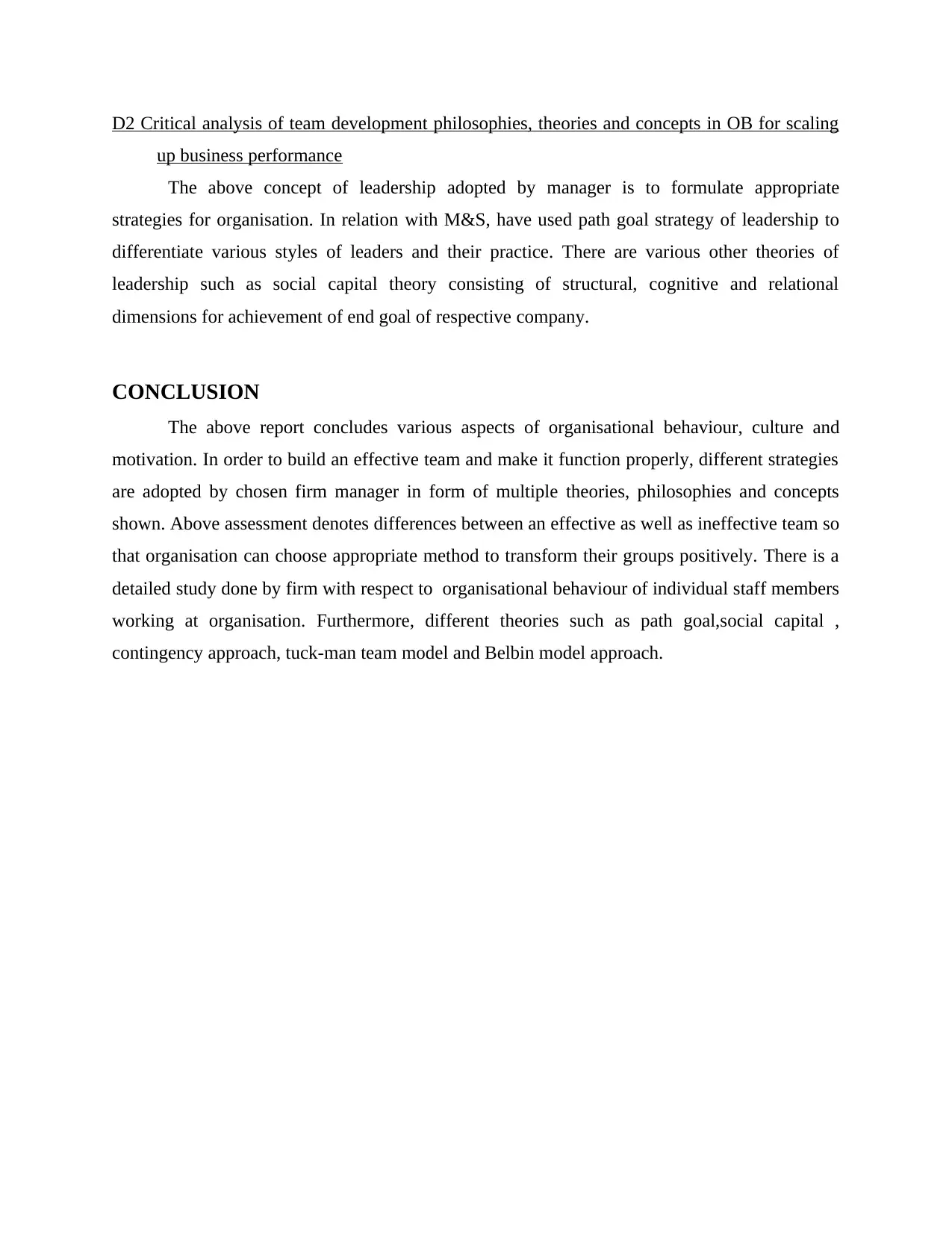
D2 Critical analysis of team development philosophies, theories and concepts in OB for scaling
up business performance
The above concept of leadership adopted by manager is to formulate appropriate
strategies for organisation. In relation with M&S, have used path goal strategy of leadership to
differentiate various styles of leaders and their practice. There are various other theories of
leadership such as social capital theory consisting of structural, cognitive and relational
dimensions for achievement of end goal of respective company.
CONCLUSION
The above report concludes various aspects of organisational behaviour, culture and
motivation. In order to build an effective team and make it function properly, different strategies
are adopted by chosen firm manager in form of multiple theories, philosophies and concepts
shown. Above assessment denotes differences between an effective as well as ineffective team so
that organisation can choose appropriate method to transform their groups positively. There is a
detailed study done by firm with respect to organisational behaviour of individual staff members
working at organisation. Furthermore, different theories such as path goal,social capital ,
contingency approach, tuck-man team model and Belbin model approach.
up business performance
The above concept of leadership adopted by manager is to formulate appropriate
strategies for organisation. In relation with M&S, have used path goal strategy of leadership to
differentiate various styles of leaders and their practice. There are various other theories of
leadership such as social capital theory consisting of structural, cognitive and relational
dimensions for achievement of end goal of respective company.
CONCLUSION
The above report concludes various aspects of organisational behaviour, culture and
motivation. In order to build an effective team and make it function properly, different strategies
are adopted by chosen firm manager in form of multiple theories, philosophies and concepts
shown. Above assessment denotes differences between an effective as well as ineffective team so
that organisation can choose appropriate method to transform their groups positively. There is a
detailed study done by firm with respect to organisational behaviour of individual staff members
working at organisation. Furthermore, different theories such as path goal,social capital ,
contingency approach, tuck-man team model and Belbin model approach.
Paraphrase This Document
Need a fresh take? Get an instant paraphrase of this document with our AI Paraphraser
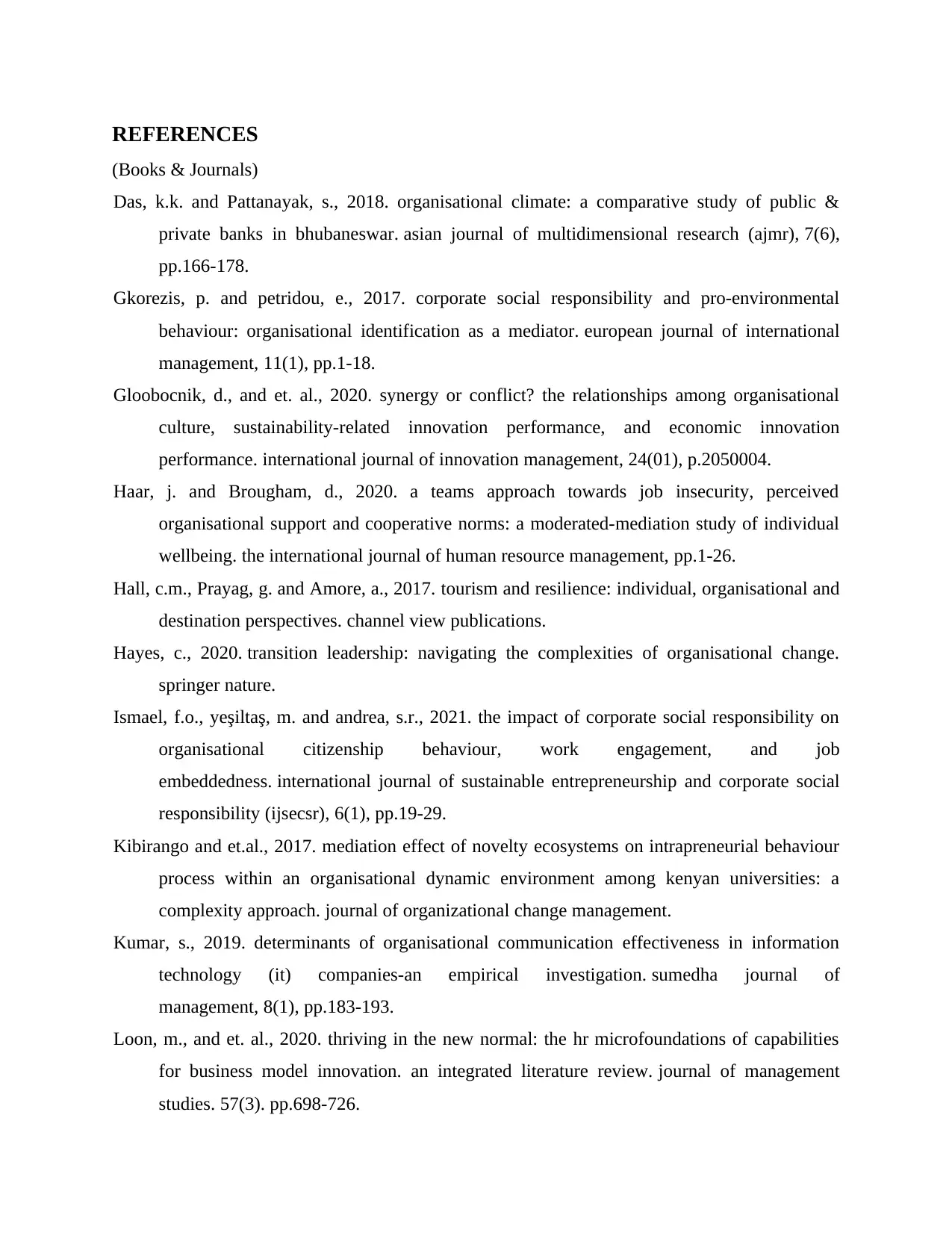
REFERENCES
(Books & Journals)
Das, k.k. and Pattanayak, s., 2018. organisational climate: a comparative study of public &
private banks in bhubaneswar. asian journal of multidimensional research (ajmr), 7(6),
pp.166-178.
Gkorezis, p. and petridou, e., 2017. corporate social responsibility and pro-environmental
behaviour: organisational identification as a mediator. european journal of international
management, 11(1), pp.1-18.
Gloobocnik, d., and et. al., 2020. synergy or conflict? the relationships among organisational
culture, sustainability-related innovation performance, and economic innovation
performance. international journal of innovation management, 24(01), p.2050004.
Haar, j. and Brougham, d., 2020. a teams approach towards job insecurity, perceived
organisational support and cooperative norms: a moderated-mediation study of individual
wellbeing. the international journal of human resource management, pp.1-26.
Hall, c.m., Prayag, g. and Amore, a., 2017. tourism and resilience: individual, organisational and
destination perspectives. channel view publications.
Hayes, c., 2020. transition leadership: navigating the complexities of organisational change.
springer nature.
Ismael, f.o., yeşiltaş, m. and andrea, s.r., 2021. the impact of corporate social responsibility on
organisational citizenship behaviour, work engagement, and job
embeddedness. international journal of sustainable entrepreneurship and corporate social
responsibility (ijsecsr), 6(1), pp.19-29.
Kibirango and et.al., 2017. mediation effect of novelty ecosystems on intrapreneurial behaviour
process within an organisational dynamic environment among kenyan universities: a
complexity approach. journal of organizational change management.
Kumar, s., 2019. determinants of organisational communication effectiveness in information
technology (it) companies-an empirical investigation. sumedha journal of
management, 8(1), pp.183-193.
Loon, m., and et. al., 2020. thriving in the new normal: the hr microfoundations of capabilities
for business model innovation. an integrated literature review. journal of management
studies. 57(3). pp.698-726.
(Books & Journals)
Das, k.k. and Pattanayak, s., 2018. organisational climate: a comparative study of public &
private banks in bhubaneswar. asian journal of multidimensional research (ajmr), 7(6),
pp.166-178.
Gkorezis, p. and petridou, e., 2017. corporate social responsibility and pro-environmental
behaviour: organisational identification as a mediator. european journal of international
management, 11(1), pp.1-18.
Gloobocnik, d., and et. al., 2020. synergy or conflict? the relationships among organisational
culture, sustainability-related innovation performance, and economic innovation
performance. international journal of innovation management, 24(01), p.2050004.
Haar, j. and Brougham, d., 2020. a teams approach towards job insecurity, perceived
organisational support and cooperative norms: a moderated-mediation study of individual
wellbeing. the international journal of human resource management, pp.1-26.
Hall, c.m., Prayag, g. and Amore, a., 2017. tourism and resilience: individual, organisational and
destination perspectives. channel view publications.
Hayes, c., 2020. transition leadership: navigating the complexities of organisational change.
springer nature.
Ismael, f.o., yeşiltaş, m. and andrea, s.r., 2021. the impact of corporate social responsibility on
organisational citizenship behaviour, work engagement, and job
embeddedness. international journal of sustainable entrepreneurship and corporate social
responsibility (ijsecsr), 6(1), pp.19-29.
Kibirango and et.al., 2017. mediation effect of novelty ecosystems on intrapreneurial behaviour
process within an organisational dynamic environment among kenyan universities: a
complexity approach. journal of organizational change management.
Kumar, s., 2019. determinants of organisational communication effectiveness in information
technology (it) companies-an empirical investigation. sumedha journal of
management, 8(1), pp.183-193.
Loon, m., and et. al., 2020. thriving in the new normal: the hr microfoundations of capabilities
for business model innovation. an integrated literature review. journal of management
studies. 57(3). pp.698-726.
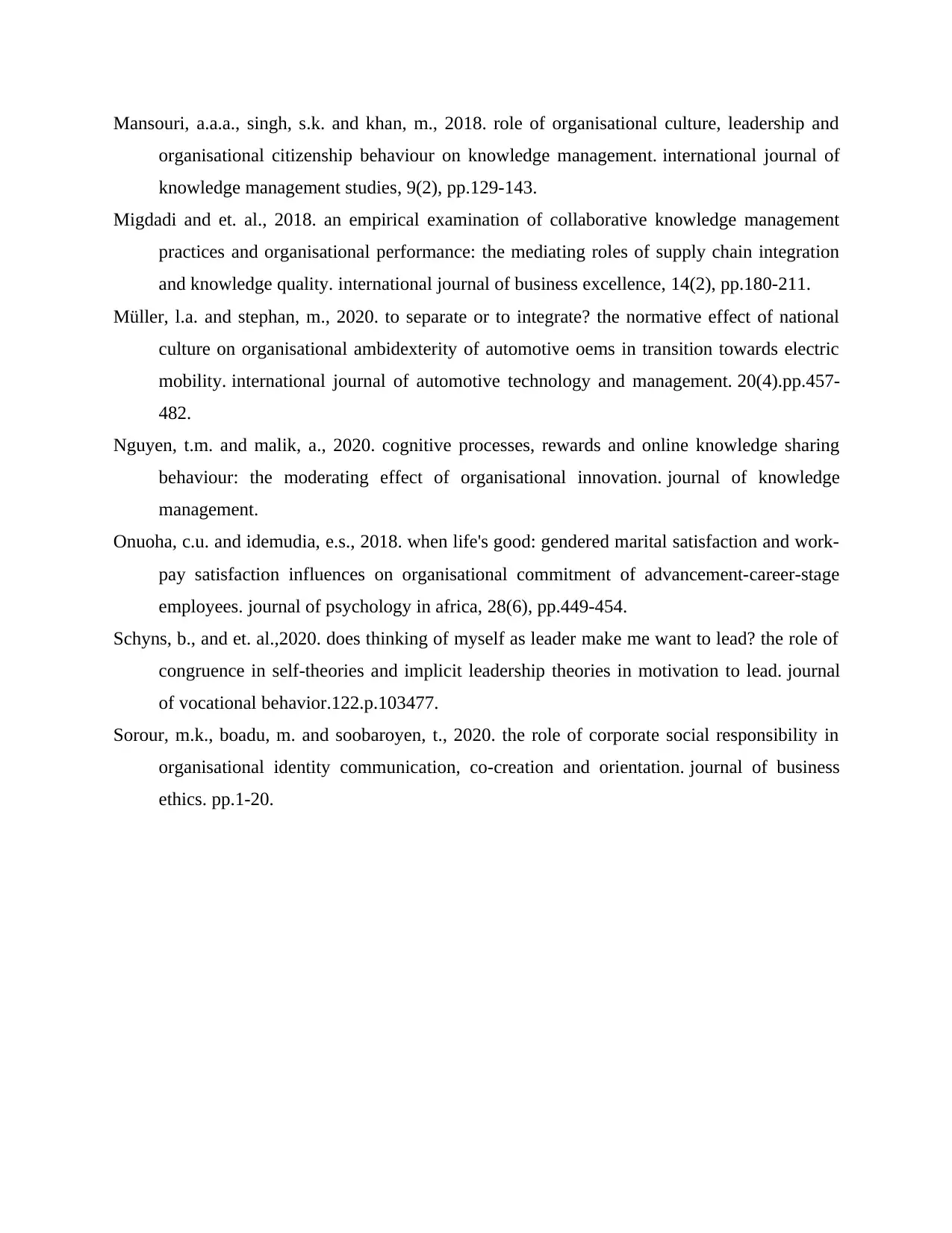
Mansouri, a.a.a., singh, s.k. and khan, m., 2018. role of organisational culture, leadership and
organisational citizenship behaviour on knowledge management. international journal of
knowledge management studies, 9(2), pp.129-143.
Migdadi and et. al., 2018. an empirical examination of collaborative knowledge management
practices and organisational performance: the mediating roles of supply chain integration
and knowledge quality. international journal of business excellence, 14(2), pp.180-211.
Müller, l.a. and stephan, m., 2020. to separate or to integrate? the normative effect of national
culture on organisational ambidexterity of automotive oems in transition towards electric
mobility. international journal of automotive technology and management. 20(4).pp.457-
482.
Nguyen, t.m. and malik, a., 2020. cognitive processes, rewards and online knowledge sharing
behaviour: the moderating effect of organisational innovation. journal of knowledge
management.
Onuoha, c.u. and idemudia, e.s., 2018. when life's good: gendered marital satisfaction and work-
pay satisfaction influences on organisational commitment of advancement-career-stage
employees. journal of psychology in africa, 28(6), pp.449-454.
Schyns, b., and et. al.,2020. does thinking of myself as leader make me want to lead? the role of
congruence in self-theories and implicit leadership theories in motivation to lead. journal
of vocational behavior.122.p.103477.
Sorour, m.k., boadu, m. and soobaroyen, t., 2020. the role of corporate social responsibility in
organisational identity communication, co-creation and orientation. journal of business
ethics. pp.1-20.
organisational citizenship behaviour on knowledge management. international journal of
knowledge management studies, 9(2), pp.129-143.
Migdadi and et. al., 2018. an empirical examination of collaborative knowledge management
practices and organisational performance: the mediating roles of supply chain integration
and knowledge quality. international journal of business excellence, 14(2), pp.180-211.
Müller, l.a. and stephan, m., 2020. to separate or to integrate? the normative effect of national
culture on organisational ambidexterity of automotive oems in transition towards electric
mobility. international journal of automotive technology and management. 20(4).pp.457-
482.
Nguyen, t.m. and malik, a., 2020. cognitive processes, rewards and online knowledge sharing
behaviour: the moderating effect of organisational innovation. journal of knowledge
management.
Onuoha, c.u. and idemudia, e.s., 2018. when life's good: gendered marital satisfaction and work-
pay satisfaction influences on organisational commitment of advancement-career-stage
employees. journal of psychology in africa, 28(6), pp.449-454.
Schyns, b., and et. al.,2020. does thinking of myself as leader make me want to lead? the role of
congruence in self-theories and implicit leadership theories in motivation to lead. journal
of vocational behavior.122.p.103477.
Sorour, m.k., boadu, m. and soobaroyen, t., 2020. the role of corporate social responsibility in
organisational identity communication, co-creation and orientation. journal of business
ethics. pp.1-20.

1
1 out of 16
![[object Object]](/_next/static/media/star-bottom.7253800d.svg)



